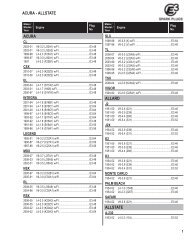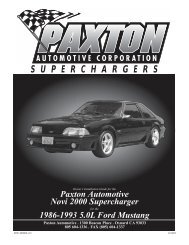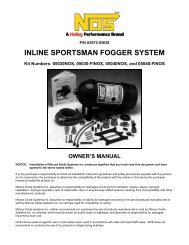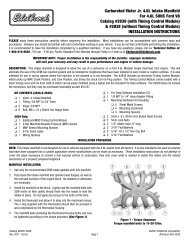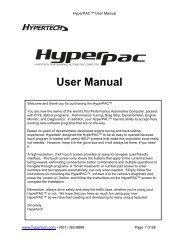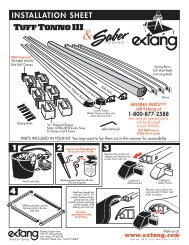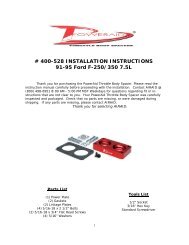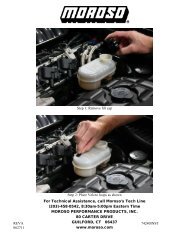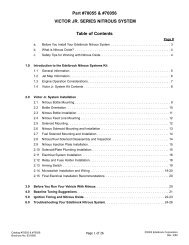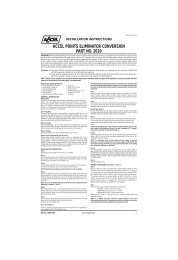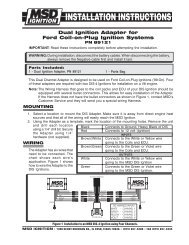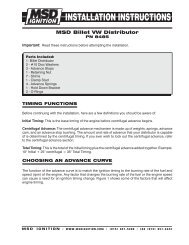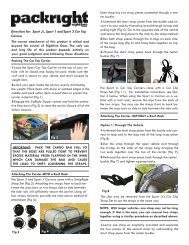limited slip differential installation
limited slip differential installation
limited slip differential installation
Create successful ePaper yourself
Turn your PDF publications into a flip-book with our unique Google optimized e-Paper software.
30. Rotate the <strong>differential</strong> case several revolutions to seat the bearings. Check the backlash<br />
as described in Step 6.<br />
31. Compare the backlash reading to the original reading taken in Step 6 and adjust as<br />
needed. To increase backlash, remove shim thickness from the ring gear side and add<br />
an equal amount of shim thickness to the opposite side. To decrease backlash, add shim<br />
thickness to the ring gear side and remove an equal amount of shim thickness from the<br />
opposite side.<br />
Note: Approximately .001” of shim equals .001” of backlash.<br />
32. Once the correct backlash reading has been established, add .004” of shim thickness to<br />
both shim packs to preload the <strong>differential</strong> bearings. It will be necessary to drive the<br />
shims into position. Do not hit the bearing cups. It is advantageous to use a Case<br />
Spreader to install the <strong>differential</strong>.<br />
33. Torque the bearing cap bolts to the proper value and rotate the <strong>differential</strong> case several<br />
revolutions to seat the bearings. Recheck the backlash and correct if necessary.<br />
34. Skip to Step 47.<br />
35. Place the <strong>differential</strong> assembly with ring gear and bearing cups into the <strong>differential</strong> carrier.<br />
36. Apply a light coat of axle oil to the bearings and adjuster nut threads.<br />
37. Install the bearing caps in their original position and hand tighten the bearing cap bolts.<br />
38. Install the adjuster nuts (unless still in the <strong>differential</strong> housing) being careful not to cross<br />
thread the adjuster nuts causing thread damage.<br />
39. With the adjuster nuts installed and the bearings in position, torque the bearing cap bolts<br />
to the proper torque value.<br />
40. For Chrysler 8-1/4 and 9-1/4, skip to Step 46.<br />
41. Loosen the RH adjuster nut (opposite the ring gear) until it is away from the bearing cup.<br />
Tighten the LH adjuster nut (ring gear side) until the ring gear is slightly forced into the<br />
drive pinion (zero backlash). Rotate the <strong>differential</strong> several revolutions to ensure no<br />
binding is present. Recheck RH adjuster nut to be sure that it is not against the RH<br />
bearing cup. Use an appropriate tool to turn adjuster nuts.<br />
42. Install indicator as shown in Figure 6. Tighten RH adjuster nut until a case spread of<br />
.008 - .012 is measured. Rotate drive pinion several times in each direction to seat the<br />
bearings and to be sure that binding does not occur. It may be necessary to readjust the<br />
case spread by tightening the RH adjuster nut.<br />
43. Measure the backlash as done in Step 6. If necessary, adjust the backlash until it<br />
matches the original reading taken in Step 6. Increase backlash by loosening the LH<br />
adjuster and tightening the RH adjuster the same amount. Decrease backlash by<br />
loosening the RH adjuster nut and tightening the LH adjuster nut the same amount.<br />
When making adjustments, always make the final adjustment in the tightening direction.<br />
For example, if the adjuster needs to be loosened one notch, loosen it two notches and<br />
tighten it one. When the proper backlash has been established, install the adjuster nut<br />
locks.<br />
10 of 13



